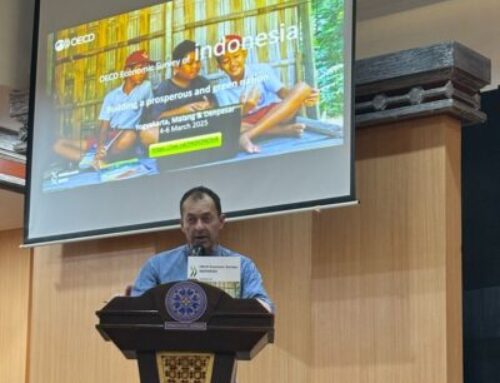FKP hosted by WRI Indonesia with Anindita Nur Annisa (WRI Indonesia) and Thang Do (The Australian National University). Thursday, 18 March 2021.
KEY POINTS:
- Renewable energy growth in Indonesia is still lagging. There is still a financing gap for renewable energy projects. Financing is not the major problem in the renewable energy sector; rather, the problem is the lack of a project pipeline. Developing an enabling environment for renewable energy will eventually affect the green bond market in Indonesia.
- Vietnam’s successful solar photovoltaic (PV) development can be a model for ASEAN countries, including Indonesia, for expanding its renewable energy sector. Vietnam was able to generate 20 times the target power generation capacity in a short time, and it now has the fastest and largest installed solar PV capacity in ASEAN. Some lessons from the Vietnam experience include the need for strong political will. Incentive instruments, particularly generous feed-in tariffs, were also a very important driver of the boom. The government’s commitment to boosting energy supply as a new economic sector and strong public demand for improved air quality have also been important underlying drivers of the progress.
SUMMARY
- Anindita Nur Annisa from WRI Indonesia discusses green bonds as an alternative financing instrument for renewable energy in Indonesia. A green bond is a debt security that is issued to raise capital specifically to support climate-related or environmental projects. The global green bond market has increased significantly over the last 10 years and about a third of it is for renewable energy. Indonesia’s government saw the potential and issued the first sovereign and corporate green bonds in Indonesia in 2018. To date, green/sustainability-linked bond issuance in Indonesia has amounted to US10.46 billion. However, its use for financing renewable energy projects in Indonesia is still very much lagging behind.
- WRI Indonesia is studying green bonds’ suitability as a renewable energy financing instrument in Indonesia. The study aims to understand what can be improved to maximize the green bond potential to be a financing instrument for renewable energy projects in Indonesia. So far it has identified several challenges to renewable energy projects and green bonds issuance:
- The lack of bankable and sizable renewable energy projects. Indonesia is lacking a renewable energy project pipeline. Due to the national monopoly of electricity, renewable energy projects depend heavily on the national plans.
- Currently, there are still no established renewable energy developers in Indonesia. The projects are mostly small and fragmented. Meanwhile, green bond issuance costs are higher for small projects and it is difficult to aggregate different projects in Indonesia.
- Barriers to renewable energy policies. The tariffs on renewable energy in Indonesia are unattractive, and the permits and bureaucracies are complicated. There are also uncompetitive domestic content requirements and difficulties to claim the import tax incentives tax.
- For the green bonds, the challenges mainly come from the lack of knowledge and capacity on green bonds and renewable energy projects. Also, the green bond policies are not yet established, there are no specific incentives for green bonds issuance. The market size of corporate bonds is still relatively small and there is a lack of impact investors in Indonesia.
- In conclusion, financing is not necessarily the major problem in the renewable energy sector in Indonesia, rather the problem is the lack of a project pipeline. Developing an enabling environment for renewable energy will eventually affect the green bond market in Indonesia. Improvements on green bonds and renewable energy must be done in parallel. Awareness and interest of the key actors and policymakers need to be built by sharing the knowledge and building the capacity for regulators, legislative, and private sectors. The government also needs to develop supporting policies for green bonds such as incentives and green bond grants. On renewable energy projects, it is important to increase renewable energy competitiveness by subsidizing renewable energy projects and de-risking renewable energy investments by optimizing the permits and bureaucracies of the projects.
- Thang Do from Australian National University presented insights from Vietnam’s solar power boom and its policy implications for ASEAN countries. Vietnam’s solar photovoltaic (PV) mega project has been a huge success. Its energy capacity increased sharply from 86 MW in 2018 to 4,750 MW in 2019. It reached 16,500 MW at the end of 2020, about 20 times the target, and is now the fastest and largest installed solar PV capacity in ASEAN. The biggest solar farm in ASEAN, the Trung Nam Thuận Nam Solar Project in Vietnam, has a capacity of 450 MW. It was built in only 102 days, inaugurated in October 2020, generating 1.2GWh per year. ASEAN has a significant potential for solar power (about 30 TW). It could play a major role in helping ASEAN achieve the renewable energy target of 23% by 2025. However, the progress in uptake is mixed. The success in Vietnam could set an example for other ASEAN countries, including Indonesia, in developing renewable energy projects.
- What were the key drivers of the Vietnam solar energy boom? Incentive instruments, particularly generous feed-in tariffs, were a very important driver of the boom. Feed-in tariffs (FIT) outperforms reverse auction and renewable portfolio standards in terms of effectiveness, timeliness, and institutional feasibility. Therefore, the FIT worked very well in the Vietnamese context. Along with the FIT, supporting policies such as income tax and land lease payment exemptions have been the key proximate drivers.
- The government has put a lot of effort into providing favorable conditions for solar PV development. The most important driver was the government’s commitment to energy security. The government’s commitment to boosting energy supply as a new economic sector and strong public demand for improved air quality also have been important underlying drivers of the progress.
- There are several policy implications for ASEAN countries, including Indonesia. Political will is needed. If there is a political will, the market will respond well to suitable incentives. Also, clean air-related health benefits can be a strong driver since in ASEAN the number of premature deaths related to air pollution is quite high. With solar PV, life expectancy could be increased across ASEAN. Also, removing fossil fuel subsidies in the electricity sector would potentially free up about 8.3 billion US dollars per year, which could be used for the next renewable energy development or other social welfare programs.





